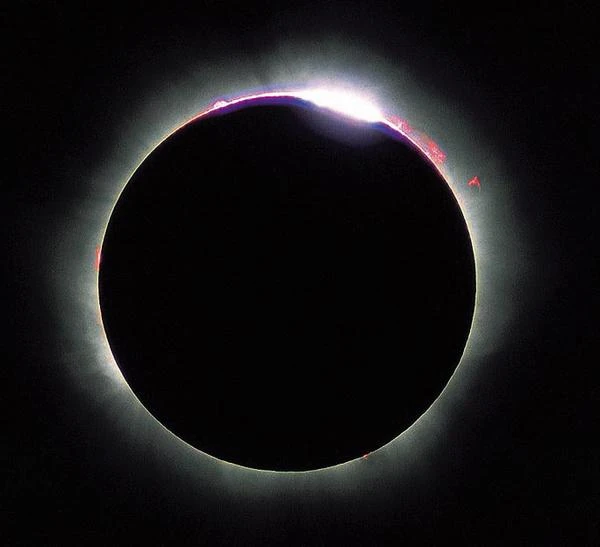
On August 11, 1999, a total solar eclipse captivated Europe, Turkey, and India. This rare phenomenon occurs when the Moon comes exactly between the Earth and the Sun. The shadow cast by the Moon on the Earth's surface temporarily plunged some regions into daytime darkness. The eclipse began off the coast of Canada and crossed Western Europe to India. In France, it was total for about 2 minutes, with maximum occultation near Reims at 12:23 UTC. This event was the last of this intensity in the 20th century visible from continental Europe.
Note: The next total eclipse that will pass through Europe will occur on September 3, 2081. The path of totality will be a bit further south and wider than this one. The shadow will cross France, Switzerland, Germany, Italy, Austria, Slovenia, Romania, Bulgaria, Turkey, Syria, Iraq, Iran, and then the Indian Ocean, ending between the islands of Sumatra and Java.
A solar eclipse occurs only during a new moon, when the Sun, Moon, and Earth are almost aligned on the plane of the ecliptic. Due to the orbital inclination of the Moon (5.1° relative to the plane of Earth's orbit), these alignments are exceptional. The apparent diameter of the Moon can be sufficient to completely occult the solar disk: this is a total eclipse. The narrow lunar shadow zone crosses the Earth's surface at several thousand kilometers per hour. This shadow, called the umbral shadow, is surrounded by a larger region of penumbra where the eclipse is partial. Predictive calculations of an eclipse involve celestial mechanics, the Saros cycle (~18 years), and the dynamics of elliptical orbits.
The solar eclipse of August 11, 1999, provided a precious opportunity to observe the solar corona, invisible outside these events. The rapid cooling of the ambient air, the silence of the birds, and the decrease in brightness remind us of the complexity of the interactions between celestial objects and their effects on our environment. From a scientific point of view, measurements of temperature, radiation, and ionospheric activity were conducted in real-time. This phenomenon was also massively observed by the public and publicized, highlighting its cultural as well as scientific impact.
It is a remarkable coincidence of celestial mechanics: the Sun is about 400 times larger than the Moon, but it is also about 400 times farther from Earth. Thus, their apparent diameters seen from Earth are almost equal (about 0.5 degrees or 30 arc minutes).
The formula for apparent diameter is: \[ \theta \approx \frac{D}{d} \] where \( D \) is the actual diameter and \( d \) is the distance to the observer.
- For the Sun: \( D = 1.39 \times 10^6 \) km, \( d = 1.496 \times 10^8 \) km → \( \theta_{\text{Sun}} \approx 0.0093 \) rad.
- For the Moon: \( D = 3.474 \times 10^3 \) km, \( d = 3.844 \times 10^5 \) km → \( \theta_{\text{Moon}} \approx 0.0090 \) rad.
These values explain why the Moon can perfectly mask the Sun, allowing for total or annular eclipses depending on its distance from Earth (perigee or apogee).
The Moon is slowly moving away from Earth at a rate of about 3.8 cm per year due to tidal effects. This orbital drift means that in a few hundred million years, the Moon will appear too small to completely mask the Sun. Total eclipses will disappear in favor of annular eclipses.
We are therefore living in an exceptional period in geological history, where orbital conditions allow for total eclipses, events that are both rare, spectacular, and rich in scientific significance.

Baily's Beads are visible not during a lunar eclipse but during a solar eclipse by the Moon. During an annular eclipse of the Sun, one can observe this phenomenon called Baily's Beads. This phenomenon is due to the topography of the Moon's surface (presence of mountains, craters, valleys, etc.). It was brilliantly described by Francis Baily (1774-1844), who noted this phenomenon in 1836.
These scratches of the Moon by the Sun's light during a solar eclipse allow the Sun's light beads to shine in some places and not in others. We know perfectly well the irregularities of the lunar profile, and astronomers can calculate in advance the appearance of the beads on the eclipse. Baily's beads appear briefly for a few seconds along the path of the eclipse. Their duration is about 1 to 2 minutes near the edges. The Red Flash appears just after the vision of Baily's beads. This very brief passage colors the solar corona a bright pink.
The red color is due to the alpha line of hydrogen that radiates at this wavelength. The diamond ring or Airy's diamond is the last portion of the Sun cutting behind the black disk of the Moon. At this moment, this image resembles a ring adorned with a diamond shining with a thousand lights. It occurs just before or just after the total eclipse.